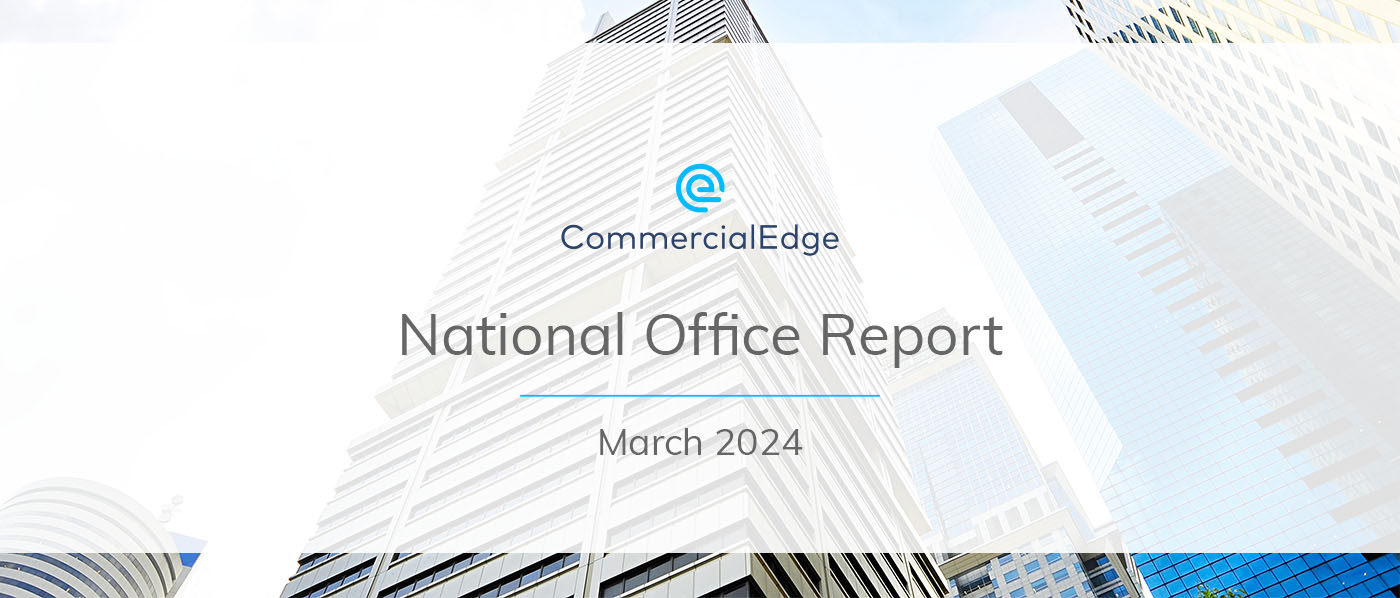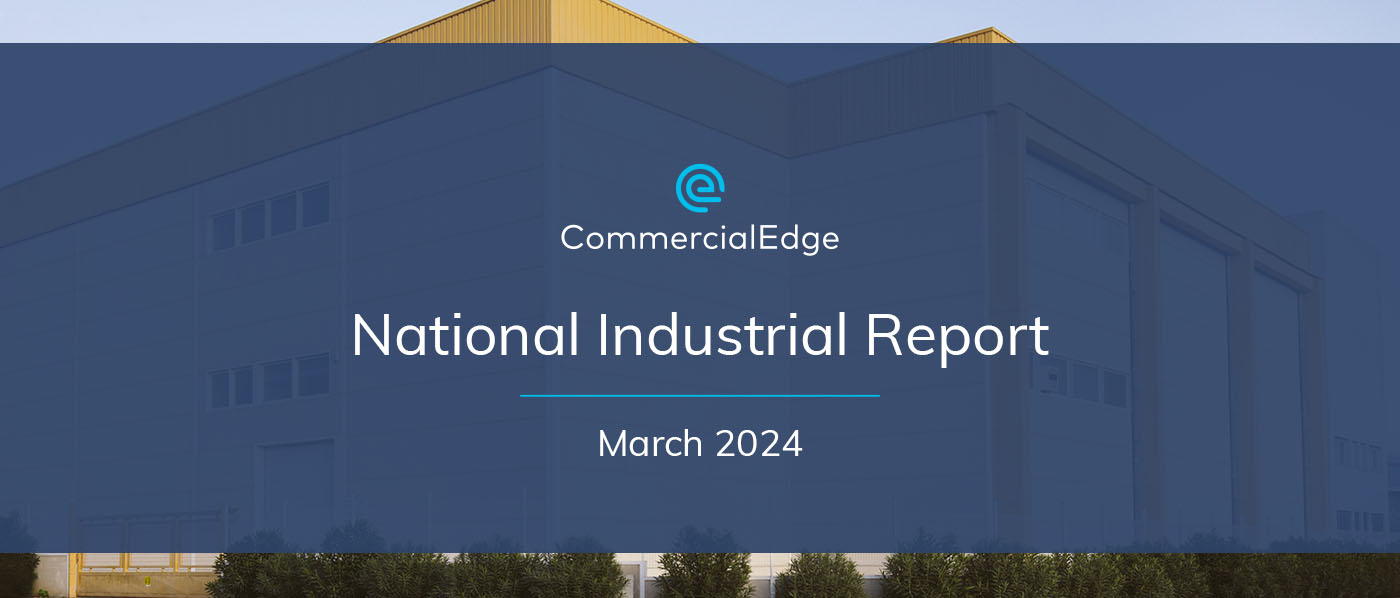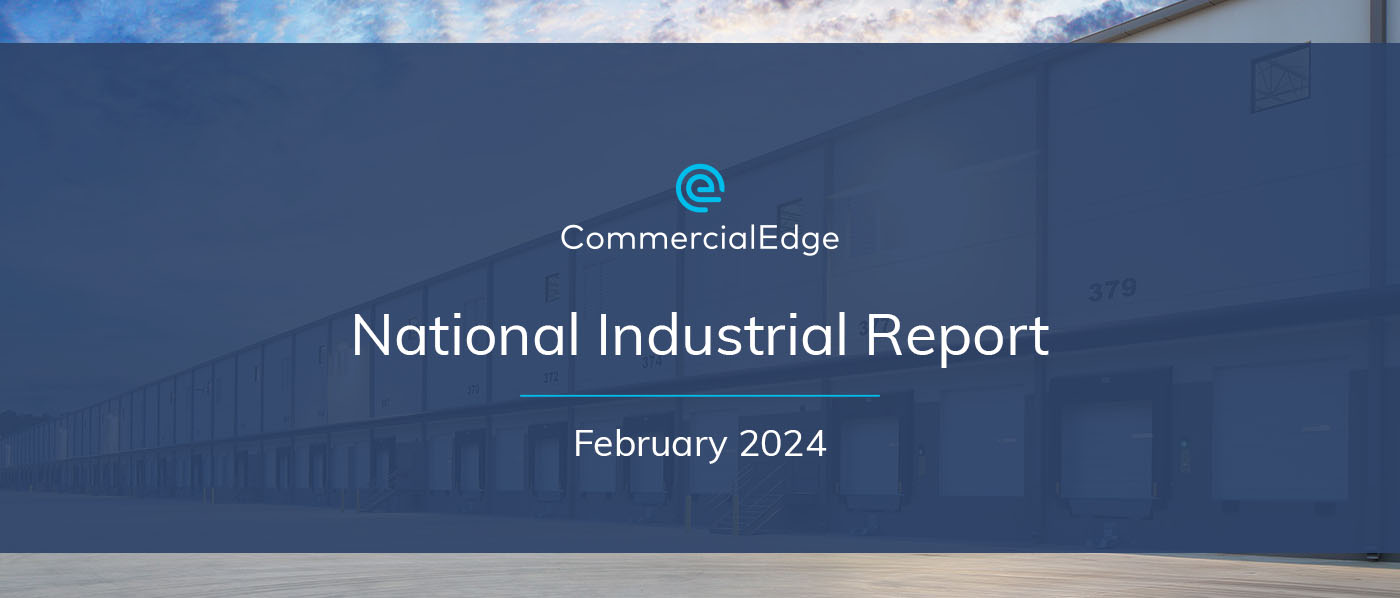Key Takeaways:
- The average U.S. office listing rate stood at $37.83, falling 1.2% year-over-year
- Up 140 basis points year-over-year, the national office vacancy rate rested at 17.9%
- Under-construction office space totaled 94.2 million square feet at the end of February, representing 1.4% of existing stock
- Office sales stood at $3.6 billion in the first two months of 2024, with assets trading at $179 per square foot
- San Francisco’s vacancy rate climbed 480 basis points year-over-year to 23.4%
- The Twin Cities logged the largest sales volume in the Midwest through February, totaling $135 million
- Washington, D.C., recorded the most significant sales volume in the U.S., closing $429 million in transactions
- Boston led the U.S. in office development, with 14.5 million square feet underway at the end of February
In the first two months of 2024, the U.S. office market continued to navigate trends shaping the sector over recent years. Among these was a noticeable adjustment in demand for office spaces, partly due to the ongoing shift towards remote and hybrid work models.
These challenges in the sector are exacerbated by higher interest rates and ongoing economic uncertainties that put pressure on upcoming maturing loans, the latest U.S. office market report shows.
As ‘extend and pretend’ moves into the next phase, we anticipate an increase in distress activity and discounted asset sales, especially if the asset is less desirable.
Peter Kolaczynski, Director, CommercialEdge
Workplace trends continue to shift in the evolving post-pandemic landscape, with office utilization and remote work rates varying widely across the U.S. Texas metros like Austin, Dallas and Houston lead the charge back to the office, while cities such as Boulder, Colo., showcase high percentages of workers embracing remote work, according to data from Kastle Systems and the Census Bureau’s American Community Survey.
Listing Rates and Vacancy: Vacancies Continue to Rise Amid Shifting Market Dynamics
The national average full-service equivalent listing rate was $37.83 per square foot in February, a decrease of 1.2% year-over-year but up 48 cents from the previous month, our most recent U.S. office market report notes.
The national vacancy rate was 17.9%, an increase of 140 basis points year-over-year. In tech hubs like Seattle, office vacancy rates have been climbing, with a notable increase of 4.3% in the past year, reaching 22.5%.
Top Listings by Metro Area: February 2024
This rise is partly due to how the pandemic has altered the traditional office work dynamic. Additionally, the tech sector began experiencing significant layoffs in late 2022, affecting large companies, including Amazon and Microsoft, and smaller tech firms based in Seattle. These layoffs have persisted over the last 18 months, exemplified by Microsoft's cut of 1,900 positions in January.
Supply: Office Construction Activity Continues to Slow
Nationally, 94.2 million square feet of office space were under construction as of January, representing 1.4% of stock, according to our U.S. office market report.
Despite a slowdown in venture capital funding for life science firms and softening demand, lab space continues to comprise a larger share of the pipeline than it did in the previous decade. Boston has the nation’s largest pipeline, driven by new lab space. A total of 14.5 million square feet (5.9% of stock) are underway in Boston, representing more than 15% of all office space being built nationally.
Office Space Under Construction (Million Sq. Ft.)
Boston’s substantial pipeline obscures the fact that development activity has slowed in recent quarters. Since the second half of last year, just 790,000 square feet have been started in Boston, with the vast majority being built for life sciences. The largest project that went vertical in the last three quarters is Alexandria Center for Life Science at 421 Park Drive, a 600,000-square-foot project in the Fenway submarket.
Transactions: Office Sales Remain Muted Through February
The U.S. office market recorded $3.6 billion in office transactions in the first two months of 2024, with properties trading at an average of $179 per square foot.
Discounted office sales have become more prevalent as market dynamics shift and vacancies rise. These sales, often transacted at prices significantly below past valuations, reflect a recalibration of office space worth in a changing work environment.
Nonetheless, some deals continued to stand out. For example, Washington, D.C.'s market saw a major boost from CoStar Group's $339 million purchase of the Central Place office tower in Arlington, significantly outpacing other markets.
2024 Year-to-Date Sales (Millions)
Western Markets: San Francisco Experiences Significant Drop in Asking Rents
U.S. office vacancy rates in major western office markets continued to rise significantly, with tech-centric metros experiencing the most notable increases. Despite the growing presence of Artificial Intelligence, San Francisco experienced the most substantial year-over-year increase in vacancy rates in the West, rising 480 basis points to 24% — the third-highest rate among the largest U.S. office markets, outpaced only by Houston’s 24.5% and Detroit’s 31.3% rate.
Nonetheless, amid the ongoing office downsizing and space optimization among companies, demand for smaller, sub-10,000-square-foot spaces remains competitive in San Francisco, according to a recent report by Kidder Matthews.
These smaller spaces are sought after by startups, small businesses or companies looking for satellite offices. Additionally, the interest in these spaces might also be driven by the desire for companies to maintain a physical presence in strategic locations while maintaining flexibility with more cost-effective solutions.
West Regional Highlights
Amid declining office occupancy rates, asking rents continued to slide in San Francisco, falling 11.1% year-over-year in February to an average of $59.81 per square foot. Despite this significant drop, San Francisco remained the most expensive office market in the West, second only to Manhattan nationally, with an average rent of $71.53 per square foot.
In the West, the Bay Area followed with rents of $54.12 per square foot, reflecting a 5.2% decrease over the past 12 months. At the other end of the spectrum stood Portland and Phoenix, with leasing rates at $27.66 per square foot and $27.82 per square foot, respectively. While Portland's asking rents decreased by 8.2% year-over-year, Phoenix stood out as the only western market to see an increase in rents, up by 1.6%.
In terms of sales, the Bay Area led the region with $416 million in closed office deals year-to-date through February. However, recent sales have seen significant discounts. For instance, a 325,200-square-foot office complex at 111 Market Square in downtown San Jose was purchased for $34.2 million, a sharp drop from its 2019 sale price of $141.4 million, The Mercury News reported.
Looking at new supply, San Diego had the largest development pipeline on a percentage-of-stock basis, with 5.3% of its total stock underway, encompassing more than 5 million square feet. Seattle came next with office projects accounting for 4.1% of the market’s inventory, comprising 5.8 million square feet.
Midwestern Markets: Chicago Starts Off the Year with Discounted Sales
Following the national trends, office transactions remained muted in the Midwest, with $276 million in closed deals across the region’s leading markets. Year-to-date through February, the Twin Cities saw the largest sales volume in the Midwest, amounting to $135 million, followed by Chicago at $117 million and Detroit at $24 million.
Office properties across the U.S. are selling for less than their loan values, confirming last year's predictions of distressed sales. In Chicago, a significant example is a 12-story building at 300 W. Adams St., which sold for $4 million, an 89% decrease from its $38 million purchase price in 2012. Additionally, Tishman Realty sold a 69,000-square-foot office building in Chicago’s CBD at a 57% discount from its $35 million purchase price in 2015.
Midwest Regional Highlights
When it comes to asking rents, the Midwest’s top office markets continued to post some of the most affordable prices nationwide. More specifically, Detroit saw the lowest rate among top markets at $22.39 per square foot, while the Twin Cities posted the third-lowest rate nationwide, at $25.84 per square foot. Meanwhile, Chicago’s average asking rent of $27.62 per square foot was the fourth lowest across the nation’s top 25 markets.
As office development continues to dwindle across the U.S., leading markets in the Midwest had some of the lowest supply pipelines nationwide. Chicago had 1.8 million square feet underway, equal to 0.6% of existing stock. At the same time, Detroit and the Twin Cities had 524,000 square feet and 486,166 square feet in the pipeline, representing just 0.4% of their respective inventories.
Southern Markets: Trophy Assets Drive Activity in Washington, D.C.
Among the nation’s top 25 office markets, Washington, D.C., recorded the largest sales volume, closing $429 million in office transactions year-to-date through February. Sales volume in the market was boosted by CoStar Group’s acquisition of Central Place Tower in Arlington for $339 million. The firm plans to relocate from its existing headquarters across the river in D.C.
Washington, D.C. also continued to be the third most expensive office market in the South, with asking rents at $40.29 per square foot, coming in after Austin’s $40.33 per square foot and Miami’s $49.64 per square foot.
The Capital also recorded lower vacancy rates than its western counterparts, coming in at 16.1%, below the national rate of 17.9%. Trophy assets especially continue to see competition in D.C. as tenants look for well-located and highly amenitized office spaces.
South Regional Highlights
New office development has been on a downward trend in the Washington, D.C. market, with no new construction starts recorded over the past eight months. As of February, the market had 3.3 million square feet of office space under construction, accounting for 0.9% of its inventory.
The largest project under construction in Washington, D.C., is a 420,000-square-foot trophy asset at 600 Fifth St., a redevelopment effort by Rockefeller Group and Stonebridge of a building originally from 1974. The project is set to come online in 2026.
Northeastern Markets: Boston Leads the U.S. in Office Construction
Among the 25 largest office markets in the U.S., Manhattan remained top for office asking rates at $71.53 per square foot, despite a 460-basis point decline compared to year-ago figures. Manhattan's asking rents still exceeded the next-highest rate, San Francisco's $59.81 (by $11.72), and surpassed the third-highest rate of $54.12 in the Bay Area (by $17.41).
In the Northeast, Boston was the only other market to record asking rents above the national rate of $37.83 per square foot, coming in at $45.62 per square foot. At the same time, asking rents stood at $34.47 per square foot in New Jersey and $31.22 per square foot in Philadelphia.
Northeast Regional Highlights
As of February, Boston had the largest development pipeline nationwide, with 14.5 million square feet of space under construction, representing 5.9% of existing stock. More than two-thirds of the space under construction in Boston has life science as its primary use type. In contrast, New Jersey had the smallest pipeline in the region in terms of square footage, with 1.9 million square feet underway, equal to 1% of its existing stock.
Office sales remained slow in the Northeast, totaling only $269 million across major markets. Breaking it down by market through February, New Jersey led with $109 million in office property sales, Manhattan followed with $77 million, Philadelphia logged $44 million, and Boston recorded $39 million in sales.
Office-Using Employment: Slowdown Continues in Labor Market’s Office Sectors
Office-using sectors of the labor market continued to decelerate in February, adding only 12,000 jobs in the month, according to the Bureau of Labor Statistics. The financial activities sector added 1,000 workers, information added 2,000, and professional and business services added 9,000. Office-using sectors grew only 0.6% year-over-year, slower than the 1.8% growth rate of the labor market as a whole.
Office Using Employment
The slowdown in office-using employment is being felt nationwide. Metro data for January, which trails the national release, shows that 71 of the 120 markets covered by CommercialEdge have seen year-over-year declines in office-using employment. Among the top 25 markets, 16 have seen negative growth over the past year, and only Miami has seen more than 2% growth. San Francisco (-5.6%), Los Angeles (-4.8%), Portland (-4.4%), Chicago (-3.6%) and San Diego (-3.5%) have recorded the largest declines among the top markets.
Trends & Industry News: Remote Work’s Varied Impact on Markets
Office utilization and work-from-home rates are uneven between markets, indicating that the pain felt in the office sector will be worse in some places than others.
Unfortunately, no data source that tracks remote work paints a complete picture. After the pandemic began in the spring of 2020, Kastle Systems started releasing a widely followed survey that tracks office utilization in 10 markets.
Kastle data shows that Texas metros such as Austin, Dallas and Houston lead in utilization rates, while large coastal markets have lower rates. Austin’s rate was more than 20% higher than San Francisco’s during the first week of March 2024.
The Census Bureau’s American Community Survey (ACS) provides details about the percentage of the working population that primarily works from home. According to the most recent data available, the share of U.S. workers primarily working from home fell to 15.2% in 2022, down from 17.9% in 2021 but nearly three times higher than in 2019.
Boulder, Colo., had the highest rate, with 32.0% primarily working from home. Austin (28.0%) was second, followed by San Francisco (27.0%), Raleigh (26.1%) and Washington, D.C. (25.4%). Austin may come as a surprise given its place atop Kastle’s metric, which reports office entry card swipes relative to pre-pandemic levels. The metro’s high levels of growth in office employment (up 32% from 2020) allow it to simultaneously have a large share of remote workers and a relatively strong recovery in office utilization.
The Census Bureau’s Household Pulse Survey is an experimental dataset that began during the pandemic in an effort to quickly deploy data for emerging issues. The most recent survey was conducted from Jan. 9 through Feb. 5 this year. While the survey provides results about households (not individuals) and only tracks the 15 largest cities, it offers another snapshot of remote work.
Among the metros tracked, Washington, D.C., had the highest share of households (52.5%) where at least one member worked from home at least one day a week, with San Francisco (46.1%), Boston (43.2%), Seattle (38.6%) and Atlanta (37.3%) rounding out the top five. Unsurprisingly, Riverside, Calif., a metro with a small portion of its labor force in office-using sectors, had the lowest share of households with someone working from home at least one day a week (17.7%), according to the Pulse Survey. Detroit (23.6%), Miami (27.6%) and Houston (29.8%) were the only other metros in the dataset, with fewer than 30% of households including someone working from home.
Download the PDF report to view more, including the map for office-using employment growth.

You can also see our previous office reports.
Methodology
This report covers office buildings 25,000 square feet and above. CommercialEdge subscribers have access to more than 14,000,000 property records and 300,000 listings for a continually growing list of markets.
CommercialEdge collects listing rate and occupancy data using proprietary methods.
Listing Rates — Listing Rates are full-service rates or “full-service equivalent” for spaces that were available as of the report period. CommercialEdge uses aggregated and anonymized expense data to create full-service equivalent rates from triple-net and modified gross listings. Expense data is available to CommercialEdge subscribers. National average listing rate is for the top 50 markets covered by CommercialEdge.
Vacancy — The total square feet vacant in a market, including subleases, divided by the total square feet of office space in that market. Owner-occupied buildings are not included in vacancy calculations.
A and A+/Trophy buildings have been combined for reporting purposes.
Stage of the supply pipeline:
Planned — Buildings that are currently in the process of acquiring zoning approval and permits but have not yet begun construction.
Under Construction — Buildings for which construction and excavation has begun.
Office-Using Employment is defined by the Bureau of Labor Statistics as including the sectors Information, Financial Activities, and Professional and Business Services. Employment numbers are representative of the Metropolitan Statistical Area and do not necessarily align exactly with CommercialEdge market boundaries.
Sales volume and price-per-square-foot calculations for portfolio transactions or those with unpublished dollar values are estimated using sales comps based on similar sales in the market and submarket, use type, location and asset ratings, sale date and property size.
Year-to-date metrics and data include the time period between January 1 of the current year through the month prior to publishing the report.
Market boundaries in the CommercialEdge office report coincide with the ones defined by the CommercialEdge Markets Map and may differ from regional boundaries defined by other sources.
Stay current with the latest market reports and CRE news
Latest Posts
Recent Reports
Industrial Sale Prices Hold Firm Amid Normalizing Demand and Shifting Capital Markets
Despite the decline in sales over recent quarters, the average sale price of industrial properties has remained high, increasing by 9.6% quarter-over-quarter and 2.0% year-over-year.
2024 to Witness Record Life Science Deliveries as Traditional Office Construction Declines
Life science facilities are an attractive office subtype, representing 27% of total office projects slated for completion by the end of 2024.
Industrial Construction Continues to Level Off Amid Normalizing Demand and High Interest Rates
New industrial starts in 2023 totaled 314.6 million square feet, down significantly from the 593.2 million square feet in 2022.






